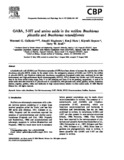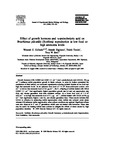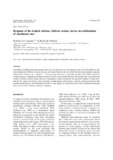| dc.contributor.author | Marcial, Helen S. | |
| dc.contributor.author | Suga, Koushirou | |
| dc.contributor.author | Kinoshita, Shigaheru | |
| dc.contributor.author | Kaneko, Gen | |
| dc.contributor.author | Hagiwara, Atsushi | |
| dc.contributor.author | Watabe, Shugo | |
| dc.date.accessioned | 2015-05-25T02:08:07Z | |
| dc.date.available | 2015-05-25T02:08:07Z | |
| dc.date.issued | 2014 | |
| dc.identifier.citation | Marcial, H. S., Suga, K., Kinoshita, S., Kaneko, G., Hagiwara, A., & Watabe, S. (2014). Molecular cloning and localization of GABAA receptor-associated protein in the rotifer Brachionus plicatilis. International Review of Hydrobiology, 99(1-2), 188-197. | en |
| dc.identifier.issn | 1434-2944 | |
| dc.identifier.uri | http://hdl.handle.net/10862/2250 | |
| dc.description.abstract | γ-Aminobutyric acid receptor type A-associated protein (GABARAP) and its homologs constitute a protein family found in many eukaryotes from yeast to human, and are known to be involved in intracellular membrane trafficking of GABAA receptors and autophagy. In this study, we cloned cDNA-encoding GABARAP from the monogonont rotifer Brachionus plicatilis and examined for its tissue distribution at the protein level in neonates, males and females. Using reverse transcription (RT)-PCR and rapid amplification of cDNA ends (RACE) techniques, we showed that like other GABARAPs, rotifer GABARAP was also composed of 117 amino acids and highly homologous to vertebrate GABARAP2 ortholog (74–76% identity). GABARAP was demonstrated with its specific antibody to be ubiquitously distributed, irrespective of neonates, males, and females, in the coronal area that covers brain and contains most mechano- and chemoreceptors. Rotifer GABARAP was also expressed in the mature eggs but not in immature eggs. Double immunostaining with mammalian anti-GABA γ receptor antibody showed that rotifer GABARAP co-localized with GABA receptor, suggesting the association of the two proteins. The presence of GABARAP in rotifer implies that it is highly conserved during evolution, and plays important roles in various biological processes. | en |
| dc.description.sponsorship | This study was partly supported by a Grant-in-Aid for Scientific Research from the Japan Society for the Promotion of Science (JSPS). | en |
| dc.language.iso | en | en |
| dc.publisher | Wiley-VCH Verlag | en |
| dc.subject | Brachionus plicatilis | en |
| dc.subject | Rotifera | en |
| dc.subject | young animals | en |
| dc.subject | gamma-aminobutyric acid | en |
| dc.title | Molecular cloning and localization of GABAA receptor-associated protein in the rotifer Brachionus plicatilis | en |
| dc.type | Article | en |
| dc.citation.volume | 99 | |
| dc.citation.issue | 1-2 | |
| dc.citation.spage | 188 | |
| dc.citation.epage | 197 | |
| dc.citation.journalTitle | International Review of Hydrobiology | en |
| dc.subject.asfa | chemoreceptors | en |
| dc.subject.asfa | antibodies | en |
| dc.subject.asfa | marine invertebrates | en |
| dc.subject.asfa | brain | en |
| dc.subject.asfa | receptors | en |
| dc.subject.asfa | proteins | en |
| dc.subject.asfa | transcription | en |
| dc.subject.asfa | hydrobiology | en |
| dc.subject.asfa | evolution | en |
| dc.subject.asfa | amino acids | en |
| dc.subject.asfa | eggs | en |
| dc.subject.asfa | reverse transcription | en |
| dc.subject.asfa | literature reviews | en |
| dc.subject.asfa | gamma-aminobutyric acid | en |
| dc.subject.asfa | phagocytosis | en |
| dc.subject.asfa | yeasts | en |
| dc.subject.asfa | membranes | en |
| dc.subject.asfa | acids | en |
| dc.identifier.essn | 1522-2632 | |
| dc.identifier.doi | 10.1002/iroh.201301720 | |
| local.subject | γ-Aminobutyric acid | en |
| local.subject | GABARAP orthologs | en |
| local.subject | Neurotransmitter | en |
| local.subject | Rotifera | en |



